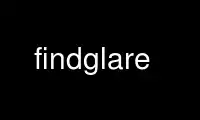
This is the command findglare that can be run in the OnWorks free hosting provider using one of our multiple free online workstations such as Ubuntu Online, Fedora Online, Windows online emulator or MAC OS online emulator
PROGRAM:
NAME
findglare - locate glare sources in a RADIANCE scene
SYNOPSIS
findglare [ -v ][ -ga angles ][ -t threshold ][ -r resolution ][ -c ][ -p picture ][ view
options ] [[ rtrace options ] octree ]
DESCRIPTION
Findglare locates sources of glare in a specific set of horizontal directions by computing
luminance samples from a RADIANCE picture and/or octree. Findglare is intended primarily
as a preprocessor for glare calculation programs such as glarendx(1), and is usually
accessed through the executive script glare(1).
If only an octree is given, findglare calls rtrace to compute the samples it needs. If
both an octree and a picture are specified, findglare calls rtrace only for samples that
are outside the frame of the picture. If findglare does not have an octree and the
picture does not completely cover the area of interest, a warning will be issued and
everything outside the picture will be treated as if it were black. It is preferable to
use a picture with a fisheye view and a horizontal and vertical size of at least 180
degrees (more horizontally if the -ga option is used -- see below). Note that the picture
file must contain correct view specifications, as maintained by rpict(1), rvu(1), pfilt(1)
and pinterp(1). Specifically, findglare will not work on pictures processed by pcompos(1)
or pcomb(1). It is also essential to give the proper rtrace options when an octree is
used so that the calculated luminance values are correct.
The output of findglare is a list of glare source directions, solid angles and average
luminances, plus a list of indirect vertical illuminance values as a function of angle.
Angles are measured in degrees from the view center, with positive angles to the left and
negative angles to the right.
By default, findglare only computes glare sources and indirect vertical illuminance for
the given view (taken from the picture if none is specified). If the view direction is
not horizontal to begin with (ie. perpendicular to the view up vector), findglare will
substitute the closest horizontal direction as its view center. The -ga option can be
used to specify a set of directions to consider about the center of view. This
specification is given by a starting angle, ending angle, and step angle like so:
start-end:step
All angles must be whole degrees within the range 1 to 180. Multiple angle ranges may be
separated by commas, and individual angles may be given without the ending and step
angles. Note that findglare will complain if the same angle is given twice either
explicitly or implicitly by two ranges.
Findglare normally identifies glare sources as directions that are brighter than 7 times
the average luminance level. It is possible to override this determination by giving an
explicit luminance threshold with the -t option. It usually works best to use the 'l'
command within ximage(1) to decide what this value should be. Alternatively, one can use
the 't' command within rvu(1). The idea is to pick a threshold that is well above the
average level but smaller than the source areas.
If the sources in the scene are small, it may be necessary to increase the default sample
resolution of findglare(1) using the -r option. The default resolution is 150 vertical
samples and a proportional number of horizontal samples. If besides being small, the
sources are not much brighter than the threshold, the -c flag should be used to override
findglare's default action of absorbing small sources it deems to be insignificant.
The -v flag switches on verbose mode, where findglare reports its progress during the
calculation.
EXAMPLE
To calculate the glare sources in the image "scene.hdr":
findglare -p scene.hdr > scene.glr
To compute the Guth visual comfort probability from this result:
glarendx -t guth_vcp scene.glr
To compute the glare for a set of angles around the view "good.vp" from the octree
"scene.oct" using an ambient level of .1:
findglare -vf good.vp -ga 10-60:10 -av .1 .1 .1 scene.oct > scene.glr
Use findglare online using onworks.net services
